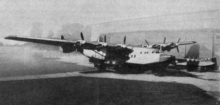Potez-CAMS 161
| Potez-CAMS 161 | |
|---|---|
 Potez-CAMS 161, recorded on August 18, 1942 |
|
| Type: | Flying boat |
| Design country: | |
| Manufacturer: | |
| First flight: |
March 20, 1942 |
| Number of pieces: |
a prototype |
The Potez CAMS-161 was one of the three largest seaplanes ever built in France .
history
The six-engine flying boat Potez-CAMS 161 with a span of 46 meters was developed by the aviation company CAMS in the late 1930s . It was intended as a passenger aircraft for Air France Transatlantique's planned North Atlantic route in the late 1930s . The designer was Maurice Hurel, who also carried out the test flights himself.
Design and development
At the beginning of 1938, CAMS tested the aerodynamics with a smaller 161 flying boat with space for two pilots and a technician. The Potez-CAMS 160 in a scale of 5:13 had a wingspan of 12.37 meters and six engines with 40 hp each. The test machine was presented after its first flight in June 1938 at the Salon de l'Aéronautique in Paris .
The first flight of the Potez-CAMS 161 followed on March 20, 1942. A contemporary report gives the first flight date as December 7, 1939 and reports on further flight tests in the first half of 1942. Almost at the same time, the Groupe Latécoère launched the passenger flying boat Latécoère 631 and at the Société Nationale de Constructions Aéronautiques du Sud-Est developed the SNCASE SE.200 , which, however, only made its maiden flight after the CAMS 161.
construction
The Potez-CAMS 161 was an all-metal flying boat with semi - cantilever wings in shoulder- deck construction, provided with bilateral support floats. The wing was braced on each side towards the lower fuselage. The horizontal stabilizer with a slight V position had a vertical stabilizer on each outside . The six Hispano-Suiza engines were housed in the wings. The passenger cabin with 40 seats and bedrooms had ten square windows on each side of the fuselage. The first lighter version of the Potez-CAMS 161 with 20 seats and a permissible take-off weight of 37,000 kg was no longer built. The data below refer to the Air France Atlantic version, which was registered in France and painted in the typical Air France colors.
Whereabouts
The last recording of the Potez-CAMS 161 is in the Museum of Sartrouville , which also exhibits a photo taken in April 1944 just before the machine was destroyed in September 1944. At that time, the Potez-CAMS 161 had the camouflage of the German air force and carried the identification mark on the flying boat hull 16 (Balkenkreuz) 11 of the German Wehrmacht . There are various reports about the exact location at which the CAMS 161 was destroyed by enemy fire towards the end of the Second World War . Hartmann describes the place on the Baltic Sea , others call Lake Constance .
Technical specifications
| Parameter | Data |
|---|---|
| crew | 6th |
| passenger | 40 |
| length | 32.11 m |
| span | 46 m |
| height | 8.87 m |
| Wing area | 261 m² |
| Empty mass | 22,979 kg |
| Takeoff mass | 43,001 kg |
| Cruising speed | 300 km / h |
| Top speed | 335 km / h |
| Range | 6,000 km, at 60 km / h headwind and full payload and standard fuel capacity |
| Engines | 6 × Hispano-Suiza 12Ydrs with 890 HP (655 kW) each |
| propeller | 6 × three-blade controllable pitch propellers |
See also
literature
- Jean Cuny: Les avions et hydravions. Editions Larivière, Paris 1992, ISBN 2848900679 .
- CG Gray: Jane's All the World's Aircraft 1938. David & Charles, London 1972, ISBN 0715 35734 4 .
Web links
- CAMS 161 with photo on histaviation.com
- "Behind the lines". Flight XLII, page 180 with picture on flightglobal.com



